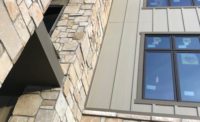First Things First: Energy Efficiency Starts With Roof Insulation
Sustainable Roofing

In the realm of building environmentally responsible rooftops, there are a number of means to an end: high R-value insulation layers, highly reflective roof surfaces, vegetative systems, photovoltaic arrays and solar thermal (i.e., hot water) systems.

All of these fall into the large category of energy efficiency, but in the construction and roofing industries, energy efficiency is often inappropriately tied to energy production — meaning the installation of a photovoltaic system, but let’s not confuse energy efficiency with energy production. While the installation of a rooftop PV system means less grid-generated energy is used (energy provided by utilities and delivered for use), the building may not be actually using less energy. True energy efficiency on rooftops starts with a well-designed and well-installed roof insulation layer
Simply put, energy efficiency is the use of less energy. For example, a building that uses less energy than it did before a renovation or upgrade is said to be more energy efficient. When a reroofing project includes an improved insulation layer, the building will be more energy efficient. This is the primary method the roofing industry is able to use when energy efficiency of a building is desired.
A high-quality roof insulation layer should be designed with multiple layers of insulation and with few, if any, thermal bridges. When installed, the insulation board joints should be offset in each direction (so no board-to-board joints align vertically). For nailable decks (wood and steel), only the first layer of insulation should be attached with fasteners; the remainder should be adhered to the layer below. For non-nailable decks (concrete), all insulation layers should be adhered to the layer below.
Air movement is a very effective way to lose energy. Everyone is familiar with the amount of energy loss from a leaky window. In fact, a few small air leaks can override a high-quality insulation layer, whether in a wall or at the roof level. While it’s hard to deny that a roofing membrane is an effective air barrier, it’s also quite important to keep air from migrating across and within the insulation layer. Therefore, it’s critical to eliminate airflow from the roof deck to the membrane. The roof deck is on the interior of the insulation, so it’s “room temperature,” and the membrane is outside the insulation, so it’s the same temperature as the outside. Air moving from the inside to the outside will greatly reduce the effectiveness of the insulation layer, which is why staggering insulation board joints is so critical for energy efficiency.
A metal fastener with a metal washer is a very good means to transfer heat energy across an insulation layer. A metal washer and fastener head just below the roof membrane will transfer heat (and cold) through the shaft of the fastener to the interior of a building. It’s the same reason the building industry doesn’t use metal framed windows anymore. When insulation needs to be fastened to a nailable deck, it’s best to fasten only the bottommost layer, and then all additional layers are adhered. This keeps the washer and fastener head within the insulation layer and therefore much closer to the interior temperature. This design eliminates the thermal bridge from the interior to the exterior.
Also important to know is the International Energy Conservation Code 2012 has very specific requirements for a roof’s insulation layer and for a building’s air barrier. Roof insulation is required to be installed in at least two layers with staggered joints.
The single-layer-of-insulation roof system is quickly becoming a thing of the past, and this will greatly increase buildings’ energy efficiency.
Looking for a reprint of this article?
From high-res PDFs to custom plaques, order your copy today!





